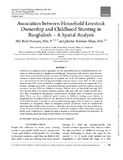Association between household livestock ownership and childhood stunting in Bangladesh – A spatial analysis
Citation
Hossain, M. B., & Khan, J. R. (2020). Association between Household Livestock Ownership and Childhood Stunting in Bangladesh - A Spatial Analysis. Journal of tropical pediatrics, 66(3), 248–256. https://doi.org/10.1093/tropej/fmz061Abstract
Livestock is an integrated part of agriculture, yet the relationship between household livestock ownership and child nutrition is a significant knowledge gap. The present study aimed to assess the association between household livestock ownership and childhood stunting and to explore the geospatial
variations at district level in Bangladesh. A complete data of 19 295 children aged below 5 years
were extracted from the latest Bangladesh Multiple Indicator Cluster Survey 2012–13. The tropical
livestock unit (TLU) score calculated as a weighted value for each livestock and categorized as low,
medium, and high using tertile. A hierarchical Bayesian spatial logistic model was used to assess the
association between TLU and childhood stunting. Children from the household with high TLU
were 10% less likely to be stunted (adjusted posterior odds ratio: 0.90, 95% credible interval: 0.84–
0.97) after controlling for demographic, socioeconomic, morbidity, place of residence and spatial
effects. There was also a substantial spatial variation in childhood stunting across districts in
Bangladesh with the highest burden in the Northern and North-Eastern regions. The positive effect
of household livestock ownership on reducing child stunting suggests that, in addition to nutritional
intervention in Bangladesh, efforts to strengthen livestock production would be beneficial for
improving child nutrition status. However, a small effect size may be owing to the lack of dietary diversity, livestock health and productivity data as well as the complexity of the relationship, requiring
further study. Furthermore, a significant regional disparity in stunting highlighted the importance of
spatial targeting during the design of interventions and implementation.

